LRM-SFB – Long-Range Multirole - Strategic Fighter-Bomber
For lower part count just remove some pylons or weapons

IMPORTANT NOTE: Aircraft has been flight-tested using a Saitek P2600 Rumble Force Gamepad for detailed handling and smoother operation. It is recommended to use a gamepad, joystick or mouse-as-joystick mode for flying this aircraft.
1) CONTROLS
• AG1: Dorsal Airbrake activation
• AG1 + GEAR Down: Wingtips Airbrakes activation
• AG2: Gyro-stabilization activation
• AG3: Internal Weapons Bay Doors operation
• AG4: ARB-115/A anti-runway penetration bomb release
• AG5: GBU-54 LJDAMs activation
• AG6: GBU-24F Enhanced Paveway III LGB activation
• AG7: Drag chute deployment
• AG8: ACTIVATED – Navigation & Anti-Col lights
• AG8: DE-ACTIVATED - Formation Lights activation
• VTOL Down: Flaps deployment
• TRIM: Normal operation (Tab-Down for Pitch-Up)
2) T/O INSTRUCTION
• TRIM: 1 TAB DOWN
• THROTTLE: 100%
• Rotate aircraft smoothly at 180mph and establish a 10° Nose-Up attitude
• GEAR UP
• TRIM: RESET for climbing attitude ~15-20° nose-up
• THROTTLE: Adjust for cruising flight ~40%
• Continue Flight
NOTE--If aircraft is not manually rotated at T/O speed, then it will rotate automatically at pre-computed T/O speed (~270mph fully loaded w/ TRIM DOWN).
3) LDG INSTRUCTIONS
ATLAS Advanced Technology Landing Approach System
(Best Landing technique due to increased operational weight):
• Reduce Airspeed below 250mph
• Align with Runway at 1.500 ft Altitude and 2NM distance
• GEAR DOWN
• THROTTLE: 8-15% (depends on weight)
• AG2: Activate for Gyro-stabilization
• AG1: Activate for Air-brakes extension
• VTOL: FULL DOWN gradually
• TRIM: FULL DOWN gradually
• Establish reasonable Rate of Descent
• Airspeed 150-185mph (depends on weight)
• Make corrections using small THROTTLE movements (~2-3%)
• Maintain Attitude 1°-3° Nose Up
• 20ft before Touchdown add 3-5% Throttle for Flare technique
• At Touchdown: THROTTLE – 0% and AG7 for Drag Chute (if needed)
• When all wheels on ground and airspeed below 130mph - APPLY FULL BRAKES
• At speed below 20mph use nose wheel steering
• Maintain ground directional stability with slight yaw inputs
4) WEAPONS
CAUTION POINTS for Air-to-Ground weapons:
• Weapons Release Velocity: 200-500mph
• Recommended Throttle setting: 30%-60%
• Keep target in front of 3-9 line
• Target always SLIGHTLY BELOW AIRCRAFT’S LINE OF SIGHT
• DO NOT fire any weapons with extreme nose-down attitude or excessive sink rate
• IT’S NOT ADVISED TO JETTISON EXTERNAL STORES UNDER NEGATIVE HIGH-G LOADING & AT HIGH SPEEDS (>700mph)

Weapons Firing Procedures
AIR-TO-GROUND
ASM-76D Stormspike (Stand-off Naval Strike Missile)
(Internal weapons bay)
• AG3 Activate (bay doors-open + Missile activation)
• Select Air-to-Ground target mode
• Select Cleaver type weapon
• Recommended Alt: >1.000ft over target
• Recommended Speed: >400mph
• Acquire target (steady red target box)
• Fire weapon
• AG3 De-activate (bay doors-closed)
>>>>>>>>>
GBU-54 L/JDAM-ER (Laser-guided extended range precision strike 500lbs bomb)
(TER-1 pylons lower hardpoints)
• AG5 Activate for bomb sensor activation
• Select Air-to-Ground target mode
• Select Cleaver type weapon
• Recommended Alt: >3.000ft over target
• Recommended Speed: 200 - 550mph
• Acquire target (steady red target box)
• Fire weapon
>>>>>>>>>
GBU-12 Paveway IV (Multisensor-guided precision strike 500lbs bomb)
(TER-2 pylons outer hardpoints)
• Select Air-to-Ground target mode
• Select Cleaver type weapon
• Recommended Alt: >3.000ft over target
• Recommended Speed: 200 - 550mph
• Acquire target (steady red target box)
• Fire weapon
>>>>>>>>>
GBU-24F Enhanced Paveway III LGB (IR/Laser-guided harden-armored precision strike 2.000lbs bomb)
(TER-2 pylon inner hardpoints)
• AG6 Activate for bomb sensor and tailfins activation
• Select Air-to-Ground target mode
• Select Cleaver type weapon
• Recommended Alt: >5.000ft over target
• Recommended Speed: 200 - 550mph
• Acquire target (steady red target box)
• Fire weapon
>>>>>>>>>
ARB-115/A Labrys anti-runway 250lbs penetration bomb
(Outer TER pylons)
• Select target and line-up aircraft
• Recommended Alt: 50-500ft over target
• Recommended Speed: 200-500 mph
• When aircraft approaches close to target area:
o AG4-Activate for bomb release and retarding device deployment
>>>>>>>>><<<<<<<<<<
AIR-TO-AIR
AIM-120C-7 AMRAAM (Long-Range BVR-E/M AAM)
(TER-1 pylon inner hardpoints)
• Select Air-to-Air target mode
• Select Interceptor type weapon
• Acquire target (steady red target box)
• Fire weapon
>>>>>>>>>
IRIS-T (Medium-Range I-IR AAM)
(TER-1 pylon outer hardpoints)
• Select Air-to-Air target mode
• Select Interceptor type weapon
• Acquire target (steady red target box)
• Fire weapon
>>>>>>>>>

5) AIRCRAFT OVERVIEW
The FB-39EM Strix is a twin-engine, two-seater fighter-bomber aircraft designed and manufactured by HarpiaDS for specialized precision ground and maritime strikes, electronic warfare and tactical reconnaissance missions, based on the F-177IE Magal C.2 airframe of the Israeli Air Force.
Initial designing phase started right after the completion of all IAF’s Magal C.2 deliveries and the company’s designing team has drastically redesigned basic aircraft components in record-time and in early 2009, HarpiaDS began extensive works on a Magal mock-up airframe, which has been acquired by IAF, and a series of major modifications have been implemented. These were:
• Adoption of a new HarpiaDS afterburning turbofan engine, the Aries HF-33-GA6, with a dry thrust of 26.000 lbf and thrust with afterburner over 37.000 lbf, low fuel consumption rates, extensive use of ceramic materials and advanced heat distribution systems.
• Incorporation of the modern HarpiaDS Wyvern M88-A/RS Advanced Multimode AESA Airborne Radar, specially designed for air-to-ground and air-to-air target acquisition up to 200NM. The new radar system provides very high-resolution mapping and provides long range target detection and tracking, including target classification capabilities both in air-to-ground and air-to-air modes. New radome section required in order to accommodate the larger M88 processor unit and provide sufficient room for advanced fluid-cooling system pipes and computer compartments.
• Installation of a new dorsal air-refueling receptacle system behind cockpit area.
• Redesign of air-intakes with movable intake ramp-type inlets and introduction of mesh screen technology to prevent foreign object damage (FOD) during T/O and LDG rolls and enlargement of inlet dimensions for higher airflow.
• Totally redesigned and re-engineered vertical stabilizer with advanced heatproof materials and incorporating a tail-fin top-mounted ECM and EW antenna fairing and a rudder air-brake system, GPS/GLONASS antennas and avionics cooling inlet. Also, the new aircraft has been equipped with a landing approach dorsal airbrake design and wingtip airbrakes for Short Landings operations, lower approach speeds and rapid deceleration.
• Re-engineered all-moving tailerons, with increased use of synthetic materials.
• Retrofit of stabilizing ventral fins in the aft under-fuselage section.
• Cockpit compartment reconstruction with a more streamlined canopy and modern multi-function color displays for engine monitoring, weapons system & EW control as well as NBC survivability addition and advanced environmental control system. The new canopy is equipped with the HaveGlass II+ anti-radiation coating for nuclear mission survivability and stealth features augmentation.
• Retrofit of a new landing gear system, specially designed for increased weight operations.
• Incorporation of two Conformal Fuel Tanks, with 320 us gals of fuel each, on the upper side of the fuselage, adding a total of extra 640 gals of fuel for range extension.
• Major redesign of the control surfaces such as: flap assembly, active leading-edge slat system and main wing control surfaces, offering a more durable wing construction, increased fuel capacity and aerodynamic maneuverability.
• APTERON vol.2.2 in-flight stability software (IFSS) upgrade and a newly-designed AFCS, allowing better low-speed handling, landing approach and weapons release flight envelope extension.
• Incorporation of the new EOS-5U Obsidian electro-optical targeting & imaging system under the nose section, for multi-spectral electro-optical ISTAR data acquisition and digital imaging under any weather conditions and laser-spot target positioning for third-party weapons guidance.
• Multiple weapons release certifications of all NATO and US-made cruise and anti-ship missiles, standoff munitions, AA missiles and general-use bombs.
• Adoption of the Triple Ejector Rack type TER-22I-G and type TER-23F-M, capable of carrying multi-purpose armaments under a single wing hardpoint.
• Inclusion of the P500-DTI LaserClaw target pod and the N300-TF NightOwl night navigation terrain-following pod in underfuselage pylons, both developed and constructed by HarpiaDS’ avionics division.
• Addition of the S8800-PS Eclipse tactical all-around self-protection system and the ES-41/A Cerberus advanced ECM system suite on top of tail fin and the KL-100-IRT Wombat infra-red track sensor in front of the canopy.
• New Radar Absorbent Material paint (tactical grey camo) and partial fuselage redesign for low-observability enhancement and limited stealth characteristics.

First prototype roll-out (tail number H001-F39) occurred in April 2011 and initial test flights commenced in early summer of the same year. The new fly-by-wire control system performance exceeded all expectations and allowed for further air testing of different configurations and speeds. Weapons systems and combat avionics equipment test completed in May 2012 and minor modifications have been incorporated to the airframe by the end of the year. At the 2013 Paris Air Show in Le Bourget airport, HarpiaDS presented the new fighter under the designation FB-39EM Strix (Fighter Bomber – Electronic attack Multirole) following an impressive live air show by company’s main test pilot Ershiv Gennnel, a former Colonel of the Israeli Air Force. In February 2014, HarpiaDS conducted adverse weather and night-time air-refueling certification flights using a Saudi Arabian A330MRTT and a French KC-135FR tanker aircrafts, testing thoroughly the AAR equipment.
The highly-sophisticated Strix Combat System - STRICoS has been designed as an all-weather, day and night, multi-role, advanced weapons platform fulfilling the following major roles:
Counter Air:
• Offensive Counter Air (OCA)
• Suppression of Enemy Air Defence (SEAD)
• Defensive Counter Air
• Active Air Defence (AAD)
Counter Land:
• Air Interdiction (AI)
• Surface Attack Operations (SAO)
• Close Air Support
• Strike Coordination and Reconnaissance (SCAR)
• Tactical Air Reconnaissance (TAR)
• Low Level Penetration (LLP)
Counter Sea:
• Anti-Surface Warfare (ASuW)
The key element of the FB-39EM Strix is the extensive air-to-ground capability and the multi-mission adaptiveness that is performed through the latest upgrade of the combat system, designated as Enhanced Capability Package 9B.2F (ECP-9B.2F). It can carry a wide range of laser guided bombs, medium range cruise missiles, anti-ship missiles, anti-radar missiles, JDAM, LJDAM, Paveway-type LGB, SDB I&II, Brimstone attack munitions, special munition dispersers and even external fuel tanks. Also, the FB-39EM Strix includes the already-retained legacy conventional freefall/retarded dumb bombs capability. Due to the variety of weapons and equipment integrated into the Strix 9B.2F Combat System, the aircraft has the ability to achieve various strategic, operational and tactical level objectives.
All of the on-board weapons can be fired on position information from the target pods or the TDL, without acquiring the target via the main radar unit or even activating the Radar unit, until after launch. The FB-39EM Strix can, also, be configured with various targeting and reconnaissance pods including the Litening III&IV, Sniper-XR, LANTIRN and the Damocles Target Pod. Typical air defensive weapons consist of IRIS-T IIR-AA short-range missiles, AIM-120C-7 AMRAAM AA-BVR long-range missiles and TJ-10A Rattler I-IR-AA medium-range missiles or a combination of the above. The aircraft is also equipped with one internal GAU-55G/S Bludgeon 30mm cannon capable of firing 2400 rounds per minute.
For extension of the combat radius two external fuel tanks can be carried on inner under-wing pylons -apart from the two dorsal CFTs- and the aircraft is equipped, also, with a dorsal in-flight refueling receptacle. So, all the modern tactical bombing profiles (Hi-Lo-Hi/Lo-Lo-Lo) can be flown in order to destroy, disrupt or delay the enemy’s surface potential before it can be used effectively against friendly forces or assets.
The FB-39EM Strix has many embedded specialised mission equipment optimised for electronic reconnaissance roles and electronic combat. The Emitter Location System (ELS) located in wingtip pods and atop of the tail fin of the aircraft, can detect, locate and classify enemy emitters, including air defence radars and communications stations and transmissions and can deploy automatically active or passive countermeasures and jam enemy emissions.
For navigation and targeting purposes, the FB-39EM Strix is equipped with an integrated Global Positioning Inertial Navigation System (GPINS) and also with a sophisticated E/O system that include a Laser/I-IR Ranger and Marked Target Seeker (LIRMTS), designated as EOS-5U Obsidian, that can be used to locate targets on the ground or in the air and can provide accurate target data to other inter-connected platforms. Additionally, the N300-TF NightOwl night navigation terrain-following pod provides accurate low-level penetration guidance in fully automated flight modes.

The FB-39EM Strix has been designed as a world-class leading combat aircraft in the specialised field of all-weather, day and night tactical strike/reconnaissance role. The two pods currently in use contain advanced reconnaissance and target sensors and greatly increase the effectiveness of the aircraft in the reconnaissance/strike role. The stand-off range of the sensors also allows the aircraft to remain outside of heavily defended areas, thus minimizing the aircraft’s exposure to enemy air-defence systems. Additional capability in the Non-Traditional Intelligence Surveillance and Reconnaissance (NTISR) role is provided by the P500-DTI LaserClaw target pod and the use of the Link-16 data link for providing tactical operators with real time Full Motion Video (FMV) in the battle space.
Many nations expressed official interest for purchasing the new FB-39EM Strix multirole strategic strike fighter in order to enhance or replace their strike fighter fleets. Amongst them are: Saudi Arabia, Singapore, Japan, S. Korea, Australia, Canada, Italy, Germany, Poland and Israel. The governments of the aforementioned countries have sent official Letters of Information at HarpiaDS, requesting further operational info and maintenance/life-cycle cost analysis with a possible purchase agreement in the near future, depending on each nation’s current fleet withdrawal timetable. Also, HarpiaDS initiated talks for industrial co-operation and FB-39EM-related technology sharing agreements with China’s state aerospace industry complex AVIC for designing PLAAF’s new strike aircraft intended to replace the H-6K and JH-7A variants currently in use.
6) SPECIAL PROCEDURES
Air-Refueling Procedure
• Recommended Altitude: 10.000-20.000ft (for safety reasons)
• THROTTLE: Retard at 12-17% (depends on weight and altitude)
• Airspeed: 180-250mph (max permissible speed: 400mph)
• AG2 Activate for Gyro-stabilization
• AG1 Activate for air-brake extension
• TRIM - FULL DOWN
• VTOL - FULL DOWN - Optional
• Monitor flight parameters and apply small throttle corrections (1-3%)

It is highly recommended to download and use the Units mod by @mushr0om for obtaining useful info during landing and/or flight.
Credits
udyog for his excellent Target Pod design of his HAL Tejas MK1 aircraft, that I upgraded with a rotating optronics head
mikoyanster for his anti-ship missile that I used to develop the ASM-76D Stormspike
xjm22 for his air-to-air missiles
closeairsupport for his IRIS-T missile design
BaconAircraft for his L-15 rudder design that I used as a basis for the new FB-39EM tailfin
EternalDarkness, ChiChiWerx, Leehopard and BogdanX for their building advises and test-flying feedback
Specifications
Spotlights
- spefyjerbf 6.4 years ago
General Characteristics
- Successors 1 airplane(s)
- Created On Windows
- Wingspan 54.1ft (16.5m)
- Length 73.0ft (22.3m)
- Height 22.1ft (6.7m)
- Empty Weight 66,247lbs (30,049kg)
- Loaded Weight 95,027lbs (43,103kg)
Performance
- Power/Weight Ratio 0.709
- Wing Loading 66.8lbs/ft2 (325.9kg/m2)
- Wing Area 1,423.5ft2 (132.3m2)
- Drag Points 15973
Parts
- Number of Parts 1210
- Control Surfaces 6
- Performance Cost 5,395

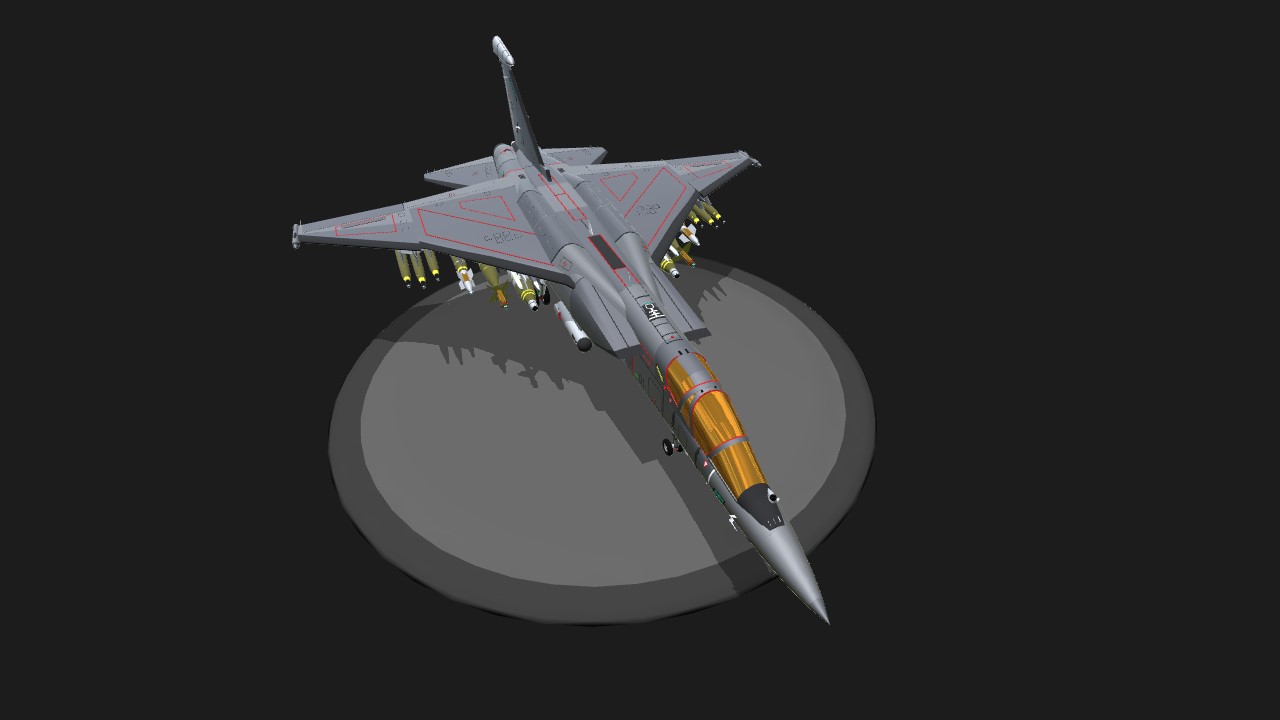
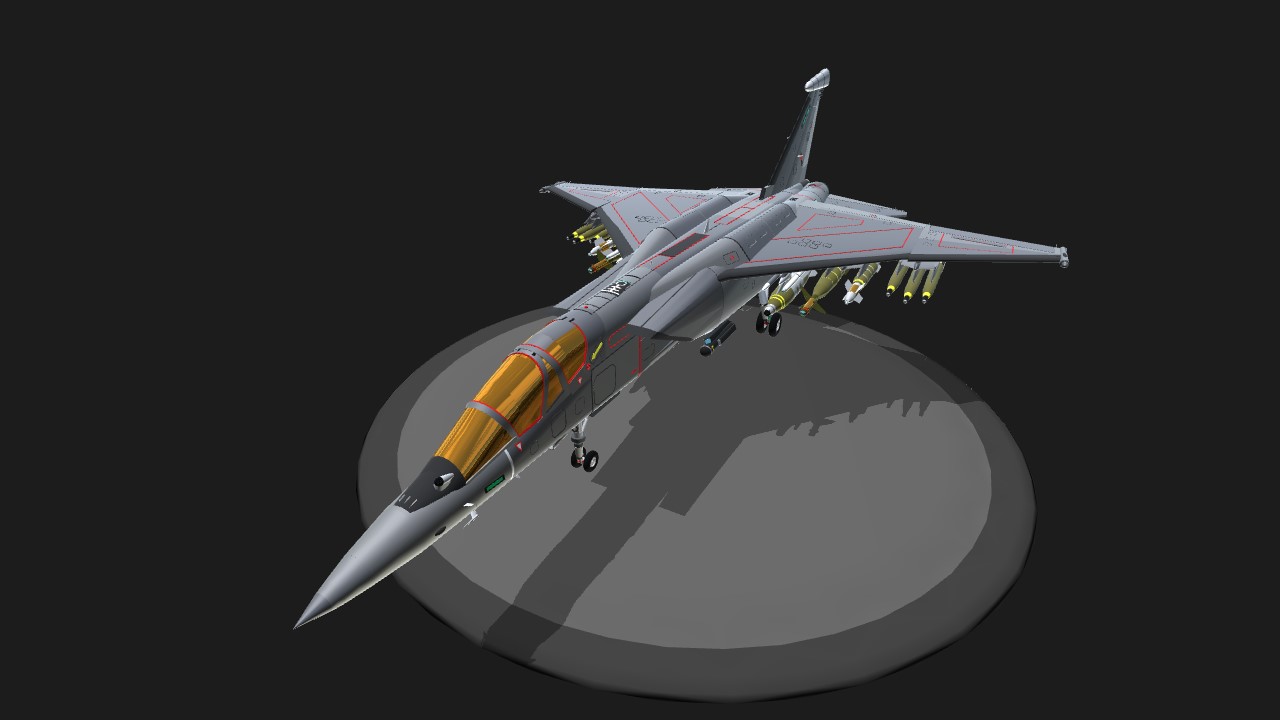
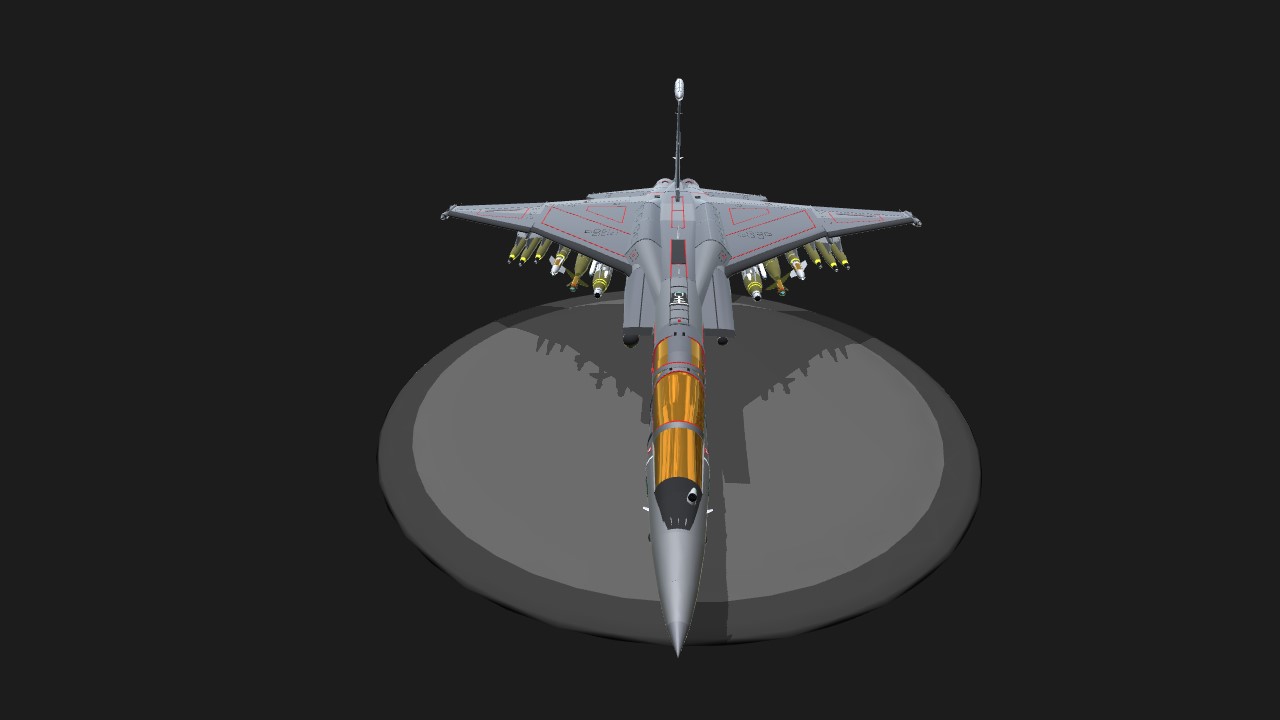
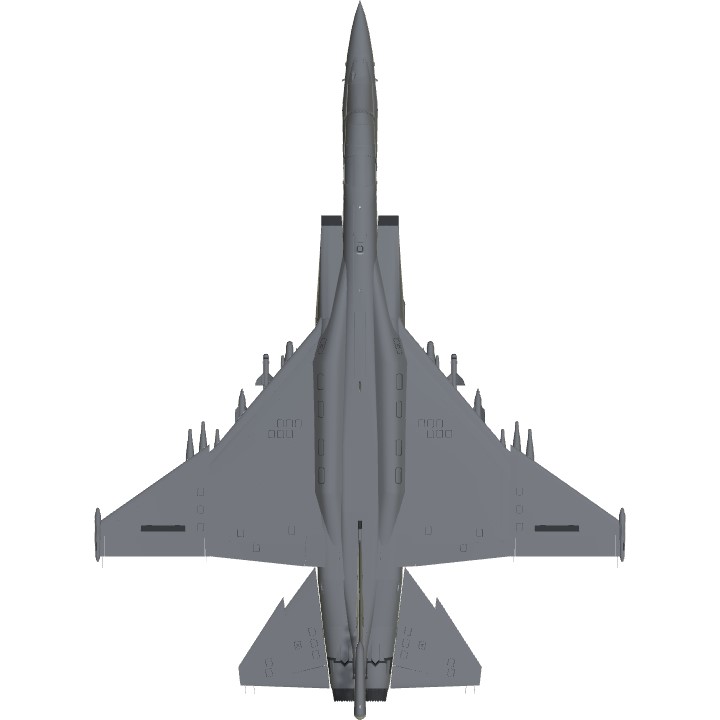
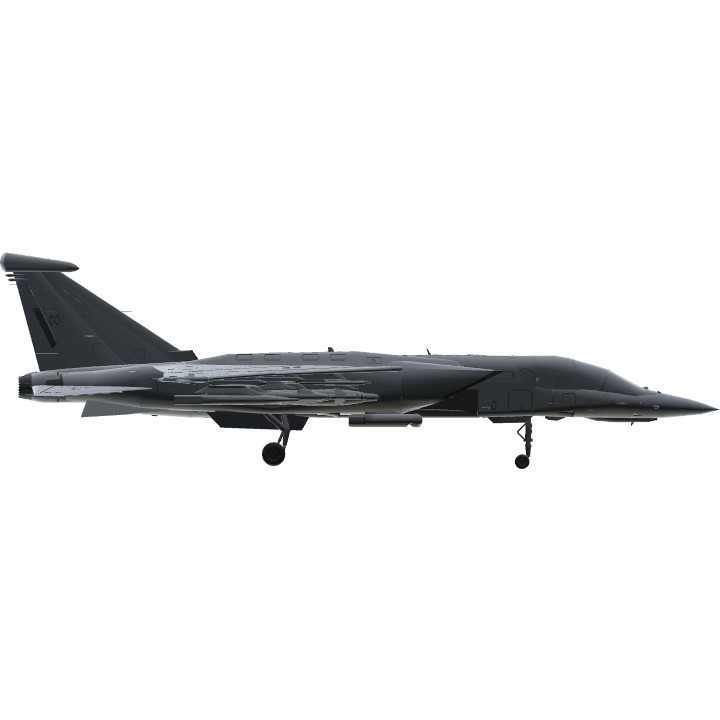
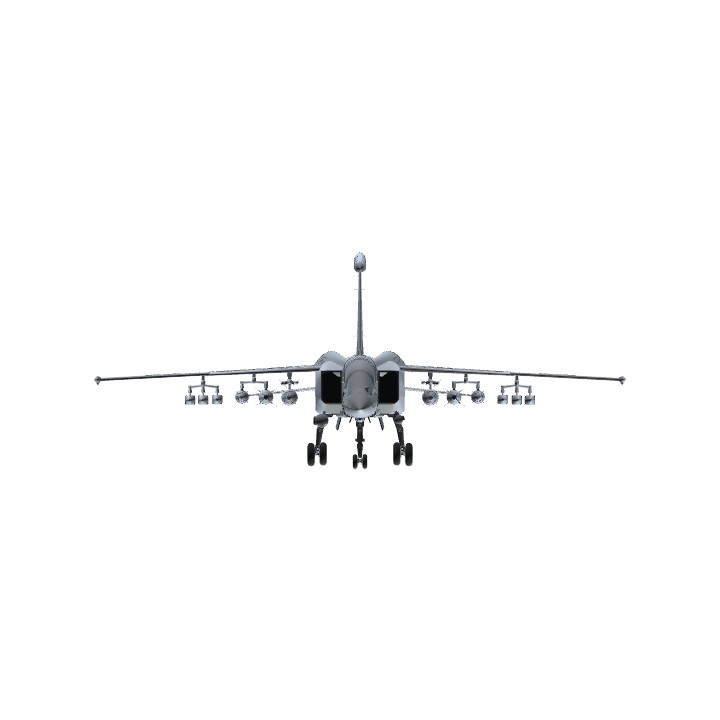
@Franticmatty If u wanna check this out and put it on ur next vid. See details on description.
As usual, wonderful design and description. The equipment chart stood out to me - a good way to convey a ton of information in one image!
Very sleek design. Great build! It does sort of remind me of my Triton, which is why I love it so much!
nice photoshop
She’s a big bird!
@Alienbeef0421 Basic image editing capability...I know they look quite fake but its the best I can do...hehehe
I highly appreciate those edited pics 😀
@Morel234 It's part of the building process to write detailed descriptions! I love it!
Looks good, will download in a minute. You really like your descriptions don't you.
@Aeroman77 Thank u my friend. Its my most detailed airplane so far...over 3 months of intensive work and flight-testing....